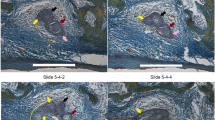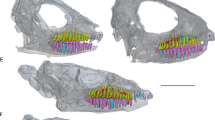Abstract
Contrary to some recent assertions, there are no persuasive ways for determining the homologies of indriid toothcomb teeth and the resulting dental formulas. Most of the presumably distinctive features of procumbent “canines” are also seen in incisors, and vice versa. Thus, there are at least three plausible dental formulas for indriid deciduous teeth and two for the permanent dentition. All formulas are compatible with the distribution of teeth in fossil strepsirhines. Similar arguments apply to strepsirhine toothcombs as a whole, but the absence of three-incisored ancestors in the fossil record strongly supports the conclusion that the dental formula of nonindriids is 2.1.3.3. for the lower dentition. There are also alternative interpretations of the original function of the toothcomb. Recent arguments which purport to demonstrate that the toothcomb evolved originally as a sap-feeding adaptation fail that purpose. The ontogeny of infant lemur behavior suggests that the original function involved grooming rather than feeding if the data are interpreted in a Haeckelian context.
Similar content being viewed by others
References
Cartmill, M., Brown, K., Eaglen, R., and Anderson, D. (1979). Hand-rearing twin ruffed lemurs (Lemur variegatus) at the Duke University Primate Center.Int. Zoo Yearb. 19: 258–261.
Charles-Dominique, P. (1971). Eco-ethologie des prosimiens du Gabon.Biol. Gabon. 7: 121–228.
Charles-Dominique, P. (1975).Ecology and Behaviour of Nocturnal Primates, University of Columbia Press, New York,
de Blainville, H. M. D. (1840). Comparative osteography of skeleton and dentar system in the five classes of vertebrate animals recent and fossil.Lancet 2: 465–470.
Delia Serra, O. (1952).A SeqŪÊnÇia Eruptiva dos Dentes Definitivos nos Simios Platyrrhina e seca InterpretaÇāo Filogenetica, Privately published, Sāo Paulo.
Doyle, G. A. (1974a). The behavior of the lesser bushbaby. In Martin, Doyle, and Walker (eds.),Prosimian Biology, Plenum Press, New York, pp. 213–231.
Doyle, G. A. (1974b). Behavior of prosimians. In Schrier and Stollnitz (eds.),Behavior of Nonhuman Primates, Vol. 5, Academic Press, New York, pp. 155–353.
Duckworth, W. L. H. (1915).Morphology and Anthropology, 2nd ed., Cambridge University Press, London.
Eaglen, R. H., and Boskoff, K. J. (1978). The birth and early development of a captive sifaka,Propithecus verreauxi coquereli.Folia Primatol. 30: 206–219.
English, W. L. (1934). Notes on the breeding of a douroucouli (Aotus trivirgatus) in captivity.Proc. Zool. Soc. Lond. 1934: 143–144.
Gingerich, P. D. (1977). Homologies of the anterior teeth in Indriidae and a functional basis for dental reduction in primates.Am. J. Phys. Anthropol. 47: 387–393.
Gingerich, P. D., and Rose, K. D. (1979). Anterior dentition of the Eocene condylarthThryptacodon: Convergence with the toothcomb of lemurs.J. Mammal. 60: 16–22.
Gregory, W. K. (1920). On the structure and relations ofNotharctus, an American Eocene primate.Mem. Am. Mus. Nat. Hist. 3: 49–243.
Harrington, J. H. (1978). Development of behavior inLemur macaco in the first nineteen weeks.Folia Primatol. 29: 107–128.
Hershkovitz, P. (1977).Living New World Monkeys (Platyrrhini), Vol. 1, University of Chicago Press, Chicago.
James, W. W. (1960).The Jaws and Teeth of Primates, Pitman, London.
Lyon, M. W. (1913). Tree shrews: An account of the mammalian family Tupaiidae.Proc. U.S. Natl. Mus. 45: 1–188.
Martin, R. D. (1972). Adaptive radiation and behaviour of the Malagasy lemurs.Phil. Trans. Roy. Soc. Lond. 264: 295–352.
Martin, R. D. (1979). Phylogenetic aspects of prosimian behavior. In Doyle and Martin (eds.),The Study of Prosimian Behavior, Academic Press, New York, pp. 45–77.
Petter, J. -J., Schilling, A., and Pariente, G. (1971). Observations éco-éthologiques sur deux lémuriens malgaches nocturnes:Phaner furcifer etMicrocebus coquereli.Terre Vie 27: 287–327.
Petter-Rousseaux, A. (1962). Recherches sur la biologie de la reproduction des primates inférieures.Mammalia 26 (Suppl. 1): 1–88.
Pollock, J. I. (1977). The ecology and sociology of feeding inIndri indri. In Clutton-Brock (ed.),Primate Ecology, Academic Press, New York, pp. 37–69.
Richard, A. (1977). The feeding behavior ofPropithecus verreauxi. In Clutton-Brock (ed.),Primate Ecology, Academic Press, New York, pp. 71–96.
Schultz, A. H. (1935). Eruption and decay of the permanent teeth in primates.Am. J. Phys. Anthropol. 19:489–581.
Schwarte, J. H. (1974). Observations on the dentition of the Indriidae.Am. J. Phys. Anthrop. 41: 107–114.
Schwartz, J. H. (1978). Homologies of the toothcomb.Am. J. Phys. Antkropol. 49: 23–30.
Schwartz, J. H. (1979). Growth, function, and homology: Aspects of dental replacement in toothcombed strepsrhines.Am. J. Phys. Anthropol. 51: 425–432.
Shigehara, N. (1974). On tooth replacement inTupaia glis. In Kondo, Kawai, and Ehara (eds.),Contemporary Primatology, Karger, Basel, pp. 20–24.
Simpson, G. G. (1967). The Tertiary lorisiform primates of Africa.Bull. Mus. Comp Zool. 136: 39–62.
Sussman, R. W. (1977). Feeding behavior ofLemur catta andLemur fulvus. In Clutton-Brock (ed.),Primate Ecology, Academic Press, New York, pp. 1–36.
Swindler, D. R. (1976).Dentitions of Living Primates, Academic Press, New York.
Szalay, F. S., and Delson, E. (1979).Evolutionary History of the Primates, Academic Press, New York.
Author information
Authors and Affiliations
Rights and permissions
About this article
Cite this article
Eaglen, R.H. Toothcomb homology and toothcomb function in extant strepsirhines. Int J Primatol 1, 275–286 (1980). https://doi.org/10.1007/BF02692275
Received:
Revised:
Issue Date:
DOI: https://doi.org/10.1007/BF02692275




